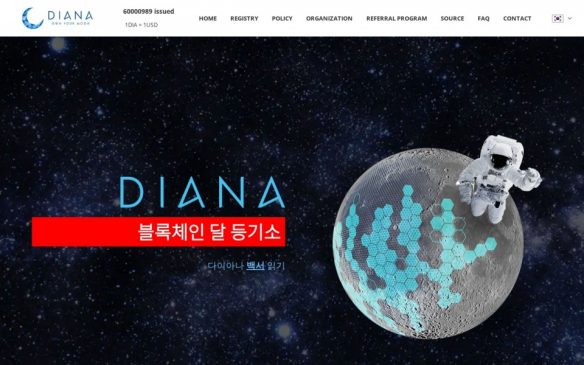For the 50th anniversary of the Apollo 11 Moon landing, a project called Diana has launched to create a land registry for the moon using Distributed Ledger Technology (DLT).
The dApp (Decentralization app) service that can mark the land of the Moon and trade it will be launched on July 20, 2019.
A Diana representative, Jason Goo said:
“The Diana project will be a great opportunity for the Moon to be a daily interest.”
According to a UN Treaty, the Moon is listed as a common heritage of mankind that no country can own. However, due to the tremendous resources of the Moon (Helium-3, a non-radioactive isotope of helium, could be used as fuel for fusion reactors to produce vast amounts of energy at very low environmental cost), competition for ownership of the Moon between certain countries and companies is becoming increasingly fierce.
Governments are jumping into a competition to create domestic laws to rival the UN Outer Space Treaty. In 2015, the United States enacted the Commercial Space Launch Competitiveness Act (CSLCA), which encourages private space development, and in 2017 Luxembourg passed a bill allowing ownership of resources mined in outer space by private companies.
Diana promotes collective registration to secure the possible right of man to the Moon to propose a solution to ‘who owns the moon’.
The Diana project is in line with the idea of combining Distributed Ledger Technology (DLT) with real estate and land in many African countries.
Until now, people and organizations with power have been using or depriving individual lands in developing countries. At this time, the land of individuals who do not register real property or ownership has been helplessly deprived.
So, for instance, the Rwandan government is working with Microsoft to carry out a land registration project using blockchain technology and the aim is to fundamentally eliminate ownership problems by digitizing land registration based on the reliability of the blockchain.
The Diana project aims to clearly define the possible rights of mankind to the Moon, given the increased possibility of ownership disputes, through collective registration.
Anybody can participate in the collective registration of the Moon using the Diana registration system. Of the approximately 3.87 billion cells generated by dividing the Moon into specific areas (approximately 9,790m²), 2 billion, on the front side of the Moon visible to the human eye, are available for now.
Participants can assign addresses with their own meaning for the selected registration area. Since it can be transferred to a third party in real-time, it can be an everlasting gift for those you love.
- KPMG Teams Up With Tomia, Microsoft And R3 To Create A Near Real-time Settlement Network For Telecom Companies – July 22, 2019
- Blockchain-Based ‘Lunar Registry’ Launched – July 22, 2019
- Daimler launches hardware Car Wallet with RIDDLE&CODE – July 22, 2019
- Ugandan President to Explore use of Blockchain to Tackle Counterfeit Drugs – July 22, 2019
- Blockchain-Based Travala.com Teams Up with Dash For Hotel Booking Payments – July 18, 2019
- SEC And FINRA Approves First Reg A+ Token Offerings – July 18, 2019
- Tokinex Tolken Sale Sells out in 35 Seconds – July 18, 2019
- 18 Organisations Launch The Convergence Alliance To Enable A New Open Data Economy Built On The Decentralized Web – July 9, 2019
- Bittrex Acquires Tradedash – July 3, 2019
- Korea’s Cube Systems Rolls Out New Blockchain eCommerce Platform – July 3, 2019
- Clinlogix Joins ALTEN Calsoft in Launching Blockchain for Clinical Trials – July 3, 2019
- Binance Charity forms alliance with 46 companies to unveil a stablecoin for the alleviation of period poverty – July 3, 2019
- Nestlé Breaks from IBM Food Trust Blockchain Group for New Milk Supply Chain Trial – July 3, 2019
- Tokeny Solutions Digital Asset Platform Gets €5 Million Backing from Euronext – July 3, 2019
- Blockchain Venture Capital Funding Reaches $822 Million in 2019 – July 1, 2019
- Toronto’s Creative Destruction Lab Joins Facebook’s Libra Association – June 19, 2019
- Australia’s Power Ledger to bring P2P Energy Trading to Austria – June 19, 2019
- Litecoin Foundation Teams Up With Bibox And Ternio On Special Edition Litecoin Debitcard – June 19, 2019
- US Legislators Call for Halt to Facebook’s Cryptocurrency Plans – And to Face Congress – June 19, 2019
- Hyperledger Welcomes Diverse Line-up of New Members for Identity Project – June 18, 2019
Also published on Medium.






